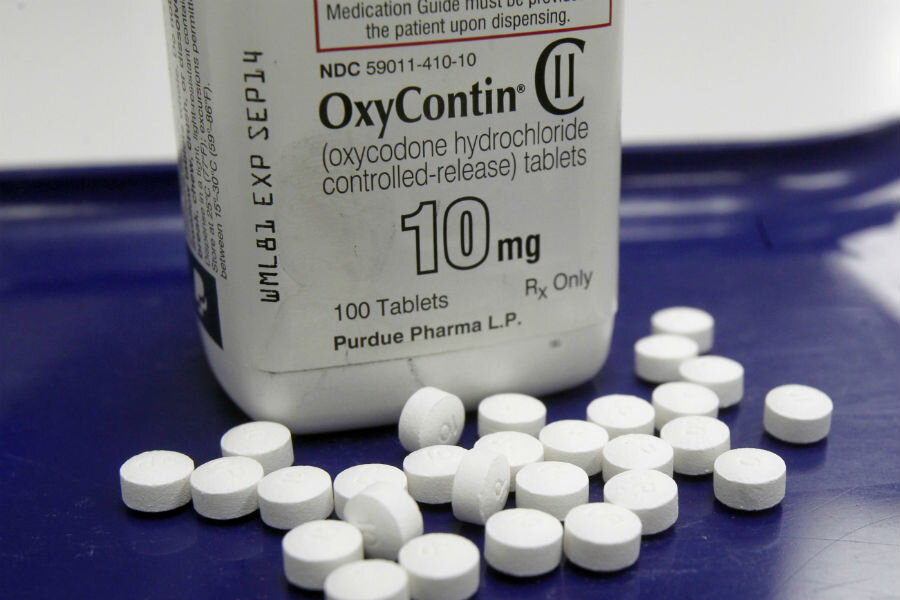Is behind-the-scenes lobbying slowing progress on opioid addiction?
Loading...
A new investigation by the Associated Press and the Center for Public Integrity found that amid surging rates of addiction, pharmaceutical companies have deployed hundreds of lobbyists to fight state-level legislation that would place limits on opioid drugs, and to ensure preferential treatment for new opioids with built-in abuse-deterrent qualities of questionable effectiveness.
Together with opioid-friendly advocacy groups, whose political advocacy work they often fund, the industry devoted more than $880 million across all 50 states on lobbying and campaign contributions between 2006 and 2015, eight times more than the famously influential gun-rights lobby spent over that same period, the investigation found.
The report’s timing coincides with a White House initiative to refocus attention onto what public health officials describe as a crisis of opioid abuse. President Obama has declared this week Prescription Opioid and Heroin Epidemic Awareness Week, unveiling treatment initiatives across a handful of government agencies and dispatching Attorney General Loretta Lynch to promote awareness in a series of speeches held in cities like Lexington, Ky., where prescription-drug addiction has been a major problem since the late 1990s.
In 2007, Purdue Pharma, the maker of OxyContin, pleaded guilty in federal court to misleading the public about OxyContin's addictive risks. Today, however, many drug companies support programs meant to deter opioid abuse: Purdue, for example, produces educational materials and has funded drug monitoring programs, among other initiatives.
"Inadequate treatment of pain and abuse of prescription pain medications are both serious public health problems that are increasingly at odds in our society," the company writes on its website, in a section titled "Opioids & Corporate Responsibility." "Corporations that make prescription pain medications have a responsibility to address both problems."
In tracking the huge sums spent by the pharmaceutical industry through its lobbying of state legislators, however, the AP and CPI investigation reveals the industry’s suspicion of reform on an issue that attracts broad bipartisan concern. But some medical experts say that while a lack of transparency makes it difficult to trace, the industry has also done much to shape debates over the crisis in opioid addiction.
"The opioid lobby has been doing everything it can to preserve the status quo of aggressive prescribing," Dr. Andrew Kolodny, an advocate for opioid prescription reform, told the AP and CPI. "They are reaping enormous profits from aggressive prescribing."
Caleb Alexander, co-director of the Center for Drug Safety and Effectiveness at Johns Hopkins University, tells The Christian Science Monitor that for many patients, opioid products are inherently risky – and not terribly effective at treating chronic pain. Nor are the abuse-deterrent formulations offered by drug companies as an alternative much less addictive, he says.
The AP and CPI reached similar conclusions in their investigation, writing that studies have shown “weak or no evidence” that opioids are effective ways to treat back pain, headaches, and other routine chronic pain.
“There’s no conflict between improving the quality of care for those with pain and reducing opioid use. What’s been set up is a false dichotomy: one of the pushes of the pharm lobby is to argue that any effort to rein in runaway prescribing is going to cause suffering and deprive people of necessary pain treatments,” Dr. Alexander tells the Monitor.
In fact, he says, “doctors have a lot of tools in the toolbox, and all too often we’ve reached for opioids prematurely. Millions of patients could be on safer, more effective alternatives,” many of which don’t involve drugs, such as physical therapy and acupuncture.
Last spring, a STAT-Harvard poll of public opinion – taken just after the Centers for Disease Control and Prevention advised doctors to limit prescriptions for opioids, except in limited circumstances – found that 55 percent of respondents expressed concern that the new guidelines would make it too difficult for people who needed prescription painkillers for medical reasons to get them, with 23 percent saying they were “very concerned.” However, 70 percent supported the guidelines' recommendation that doctors not prescribe more than three days' worth of opioids at a time, and explore other treatments first.
In July, President Obama signed the Comprehensive Addiction and Recovery Act, a bipartisan law that authorized $181 million in discretionary spending to treatment and monitoring programs. Funding hasn’t been approved for it yet, though the president is expected to push this week for the full $1.1 billion in funding he initially requested. The focus of the law is mainly on programs for monitoring and treating addiction. Other, perhaps more innovative solutions by the federal government, like a Food and Drug Administration (FDA) competition to create a phone app that can match those overdosing on opioids to someone nearby who is carrying a prescription-drug antidote, have been similarly focused on treatment.
Public demand for opioids, and legislators’ reluctance to generate a more radical shift away from them, may also be bound up with the restraints of the healthcare system. As the New York Times editorial board wrote at the end of August, doctors often turn to opioids because they’re easy to prescribe, patients demand them, and alternative treatments such as physical therapy or acupuncture either aren’t covered by insurance plans or are associated with high co-pay costs.
“One fix here seems obvious: Federal and state lawmakers can require insurers to cover these services, a cheaper option over the long term than addiction treatment,” the board wrote.








